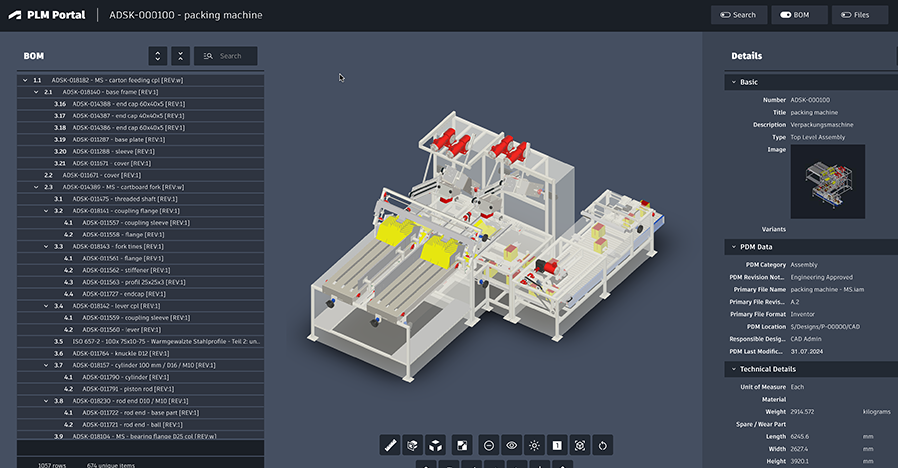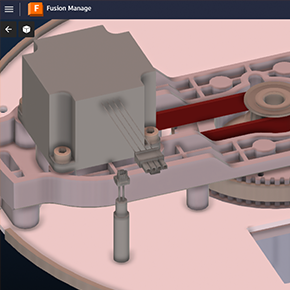At PerspectivePLM, we help businesses gain a clear, connected, and cloud-first view of their product development processes. As the first cloud-only Autodesk partner, we specialise in delivering next-generation PLM solutions powered by Autodesk Fusion Manage, enabling true digital transformation across your product lifecycle. PerspectivePLM is committed to driving the future of product lifecycle management by offering insights that streamline operations, reduce costs, and accelerate time-to-market, while ensuring exceptional product quality and compliance


Discover the PLM Appstore
The Fusion Manage Appstore is a modular ecosystem of industry standard purpose-built PLM workflows by PerspectivePLM, covering every stage of the product lifecycle. From design collaboration and BOM management to quality control, supplier collaboration, and project tracking, each PLM workflow empowers teams to streamline complex processes without writing code. Whether you're managing engineering changes, product go-to-market launches, or ensuring regulatory compliance, the PLM Appstore provides scalable tools to accelerate workflows, enhance data visibility, and connect cross-functional teams. Built on Autodesk’s flexible Fusion Manage platform, it enables rapid deployment of industry-specific solutions—tailored for aerospace, automotive, medical devices, consumer products, and more so organisations can innovate faster and operate smarter.
Benefits of PLM Appstore
The Fusion Manage Appstore offers significant advantages for organisations seeking to modernise and streamline their product development processes. By providing a curated library of configurable, ready-to-deploy applications, it eliminates the need for complex custom coding, reducing implementation time and total cost of ownership. The modular structure allows businesses to adopt only the functionality they need, scaling effortlessly as requirements evolve. Seamless integration with existing CAD, ERP, and business systems ensures a connected digital thread across departments. Additionally, the Appstore promotes standardisation and process control while remaining flexible enough to accommodate unique industry or regulatory demands. With continuous updates and Autodesk’s cloud infrastructure, organisations benefit from enhanced agility, data consistency, and a future-ready PLM platform that supports ongoing innovation.
Product Development and Design
🟧 CAD Data Management
🟧 3D Model and Drawing Management
🟧 Design Collaboration and Co-authoring
🟧 Version and Revision Control
🟧 Design Reuse and Templates
🟧 Requirements Management
🟧 Simulation and Analysis Data Management
🟧 Digital Twin Creation
🟧 Design Reviews and Approvals
🟧 Part Classification and Reuse
Bill of Materials (BOM) Management
🟧 Engineering BOM (EBOM) Management
🟧 Manufacturing BOM (MBOM) Management
🟧 Service BOM (SBOM) Management
🟧 BOM Comparison and Synchronization
🟧 Multi-level BOM Structuring
🟧 BOM Redlining and Change Tracking
🟧 BOM Variant and Configuration Management
Change and Configuration Management
🟧 Engineering Change Request (ECR)
🟧 Engineering Change Order (ECO)
🟧 Change Notification
🟧 Deviation and Waiver Management
🟧 Configuration Management
🟧 Effectivity Management
Manufacturing Process Management
🟧 Process Planning (Routing, Work Instructions)
🟧 Tooling Management
🟧 Manufacturing Readiness Reviews
🟧 PLM to MES Integration
🟧 Factory Layout and Line Simulation
🟧 Design for Manufacturability
Supplier and Sourcing Management
🟧 Supplier Collaboration Portals
🟧 Request for Quotation (RFQ)
🟧 Approved Vendor List (AVL) Management/Approved Manufacturers List (AML)
🟧 Supplier Document Exchange
🟧 Production Part Approval Process (PPAP)
🟧 Compliance and Risk Scoring
Document Management
🟧 Technical Document Control
🟧 Compliance Documentation Management
🟧 Audit Trails and Document History
🟧 Digital Signatures and Workflows
🟧 Multi-language Document Handling
🟧 Document Linking to Parts and Products
Quality and Compliance
🟧 Non-Conformance Reporting (NCR)
🟧 Corrective and Preventive Action (CAPA)
🟧 Failure Modes and Effects Analysis (FMEA)
🟧 Inspection Planning
🟧 Audit Management
🟧 Regulatory Compliance Management (RoHS, REACH, FDA, ISO)
Product Testing and Validation
🟧 Test Plan and Test Case Management
🟧 Test Result Tracking
🟧 Design Verification and Validation
🟧 Prototyping Workflows
🟧 Lab and Bench Data Capture
Project and Portfolio Management
🟧 Stage-Gate Process Management
🟧 Task Assignment and Scheduling
🟧 Milestone Tracking
🟧 Resource Allocation
🟧 Cost Estimation and Budgeting
🟧 Program Risk Management
Sales, Marketing, and Launch
🟧 Product Data for ERP and Commerce
🟧 Go-to-Market Planning
🟧 Labeling and Packaging Workflows
🟧 Localization Management
🟧 Sales BOM and Product Kit Creation
Aftermarket and Service
🟧 Service BOM and Spare Parts Management
🟧 Maintenance Procedure Management
🟧 Service Bulletin Distribution
🟧 Return Material Authorization (RMA)
🟧 Field Feedback Capture
🟧 End-of-Life Planning
Security, Access and Governance
🟧 Role-Based Access Control
🟧 Audit Logs and History
🟧 Export Control Compliance
🟧 Electronic Signatures
🟧 Data Masking and Watermarking
AI, Analytics and Intelligence
🟧 Product Analytics and Dashboards
🟧 Digital Thread Management
🟧 IoT Integration and Predictive Maintenance
🟧 AI-Based Part Suggestion or Classification
🟧 Failure Prediction using Machine Learning
Industry-Specific Examples
🟧 Aerospace & Defense – Export Compliance, Airworthiness Certification
🟧 Medical Devices – Design History File (DHF), Device Master Record (DMR)
🟧 CPG – Formula and Recipe Management, Label Compliance
🟧 Retail/Apparel – Line Planning, Seasonal Management
🟧 Automotive – APQP, Functional Safety, PPAP
🟧 Energy – Asset Lifecycle and Change Tracking
🟧 Shipbuilding – Hull Configuration, Outfitting Planning
- Faster Implementation
- Modular & Scalable
- Seamless Integration
- Industry-Ready Solutions
- Improved Process Control
- Cloud-Based Agility
The only way for success
PLM is a balanced integration of People, Process, and Technology. If even one is missing or misaligned, the whole system suffers. Success requires all three working in harmony—33.3% effort isn’t enough; you need the full 100%. Click the words to see !


